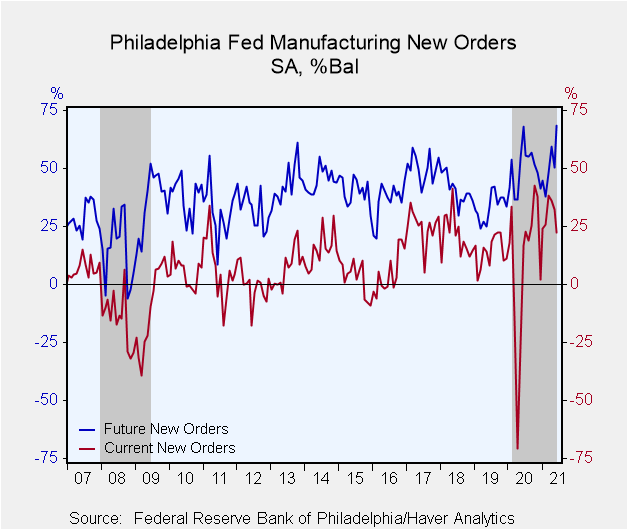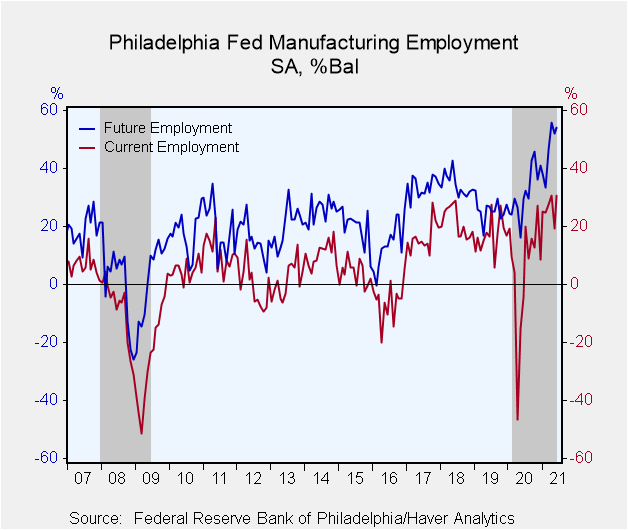 Global| Jun 17 2021
Global| Jun 17 2021Philly Fed Manufacturing Index Little Changed in June
by:Sandy Batten
|in:Economy in Brief
Summary
• Headline index off recent highs but still quite elevated. • Shipments rose though new orders moderated. • Prices paid increased to highest since 1979. • Hiring plans for next six months rose to near-record high. The Federal Reserve [...]
• Headline index off recent highs but still quite elevated.
• Shipments rose though new orders moderated.
• Prices paid increased to highest since 1979.
• Hiring plans for next six months rose to near-record high.
The Federal Reserve Bank of Philadelphia's Manufacturing Business Conditions Index edged down to 30.7 in June from 31.5 in May. This was the second consecutive monthly decline though, historically speaking, the index remains quite elevated, indicating continued strong growth in manufacturing activity. A slight increase to 31.8 had been expected by the Action Economics Forecast Survey. The percentage of firms reporting improving conditions declined to 41.6% in June from 43.4% in May; the share reporting weaker conditions also fell to 10.9% from 11.9%. The share reporting no change increased to 47.5% from 44.6%.
Haver Analytics calculates an ISM-Adjusted General Business Conditions Index using the same methodology as the national ISM index. The reading eased to 62.5 in June from 62.7 in May and 63.0 in April, which was the highest reading since March 1973.
Performance of the subindexes was mixed in June. The new orders index fell to 22.2 in June from 32.5 in May, while the shipments index increased to 27.2, the highest reading since February, from 21.0. The employment index rebounded, jumping to 30.7 in June from 19.3 in May and almost regained its record level of 30.8 posted in April. Indicators of supply restraints moderated in June but remained markedly elevated. The delivery time index fell to 29.3 from a series record 41.5 in May. The unfilled orders index declined to 22.5 from 40.4 in May, the second highest reading on record.
On the pricing front, the index of prices paid continued to rise, moving up to 80.7 in June, the highest reading since 1979, from 76.8 in May. 81.6% of respondents reported paying higher prices for inputs while only 1% reported paying lower prices. The index of prices received strengthened to 49.7 in June, its highest level since 1980, from 41.0.
The Philadelphia Fed also surveys expectations for business activity in the coming six months. In contrast to the current conditions index, the expectations for future activity index rose in June—to 69.2, its highest reading in nearly 30 years, from 52.7 in May. Expected hiring rose to 54.0 in June, just slightly below the series record set in April. Respondents expect both prices paid and prices received to continue to rise over the coming six months.
The survey panel consists of 150 manufacturing companies in the third Federal Reserve District (which consists of southeastern Pennsylvania, southern New Jersey and Delaware). The diffusion indexes represent the percentage of respondents indicating an increase minus the percentage indicating a decrease in activity. The ISM-adjusted figure, calculated by Haver Analytics, is the average of five diffusion indexes: new orders, shipments, employment, delivery times and inventories with equal weights (20% each). Each ISM-adjusted index is the sum of the percent responding "higher" and one-half of the percent responding "no change."
The figures from the Philadelphia Federal Reserve dating back to 1968 can be found in Haver's SURVEYS database. The expectation from the Action Economics Forecast Survey is available in AS1REPNA.
| Philadelphia Fed - Manufacturing Business Outlook Survey (%, SA) | Jun | May | Apr | Jun'20 | 2020 | 2019 | 2018 |
|---|---|---|---|---|---|---|---|
| General Factory Sector Business Conditions | 30.7 | 31.5 | 50.2 | 27.5 | 7.9 | 9.9 | 20.9 |
| ISM-Adjusted Business Conditions | 62.5 | 62.7 | 63.0 | 53.7 | 52.3 | 55.5 | 57.7 |
| New Orders | 22.2 | 32.5 | 36.0 | 16.7 | 8.9 | 14.1 | 21.0 |
| Shipments | 27.2 | 21.0 | 25.3 | 25.3 | 9.7 | 16.9 | 22.8 |
| Unfilled Orders | 22.5 | 40.4 | 27.2 | -0.1 | 0.4 | 7.7 | 7.0 |
| Delivery Time | 29.3 | 41.5 | 27.8 | 0.4 | 5.1 | 9.4 | 9.5 |
| Inventories | 17.9 | 25.6 | 17.3 | 0.0 | -0.2 | 5.1 | 7.2 |
| Number of Employees | 30.7 | 19.3 | 30.8 | -4.3 | 5.0 | 16.9 | 21.5 |
| Average Workweek | 20.1 | 35.5 | 29.8 | -6.5 | 4.4 | 9.8 | 15.9 |
| Prices Paid | 80.7 | 76.8 | 69.1 | 11.1 | 16.6 | 19.7 | 46.1 |
| Expectations - General Business Conditions; Six Months Ahead | 69.2 | 52.7 | 66.6 | 66.3 | 46.3 | 28.4 | 36.8 |
Sandy Batten
AuthorMore in Author Profile »Sandy Batten has more than 30 years of experience analyzing industrial economies and financial markets and a wide range of experience across the financial services sector, government, and academia. Before joining Haver Analytics, Sandy was a Vice President and Senior Economist at Citibank; Senior Credit Market Analyst at CDC Investment Management, Managing Director at Bear Stearns, and Executive Director at JPMorgan. In 2008, Sandy was named the most accurate US forecaster by the National Association for Business Economics. He is a member of the New York Forecasters Club, NABE, and the American Economic Association. Prior to his time in the financial services sector, Sandy was a Research Officer at the Federal Reserve Bank of St. Louis, Senior Staff Economist on the President’s Council of Economic Advisors, Deputy Assistant Secretary for Economic Policy at the US Treasury, and Economist at the International Monetary Fund. Sandy has taught economics at St. Louis University, Denison University, and Muskingun College. He has published numerous peer-reviewed articles in a wide range of academic publications. He has a B.A. in economics from the University of Richmond and a M.A. and Ph.D. in economics from The Ohio State University.










